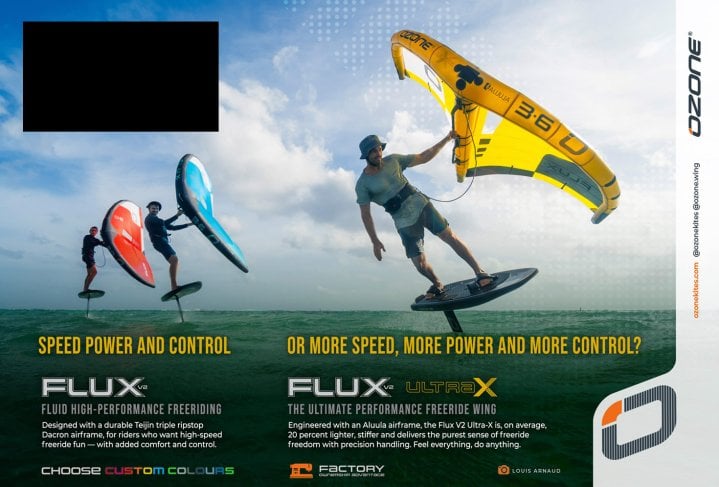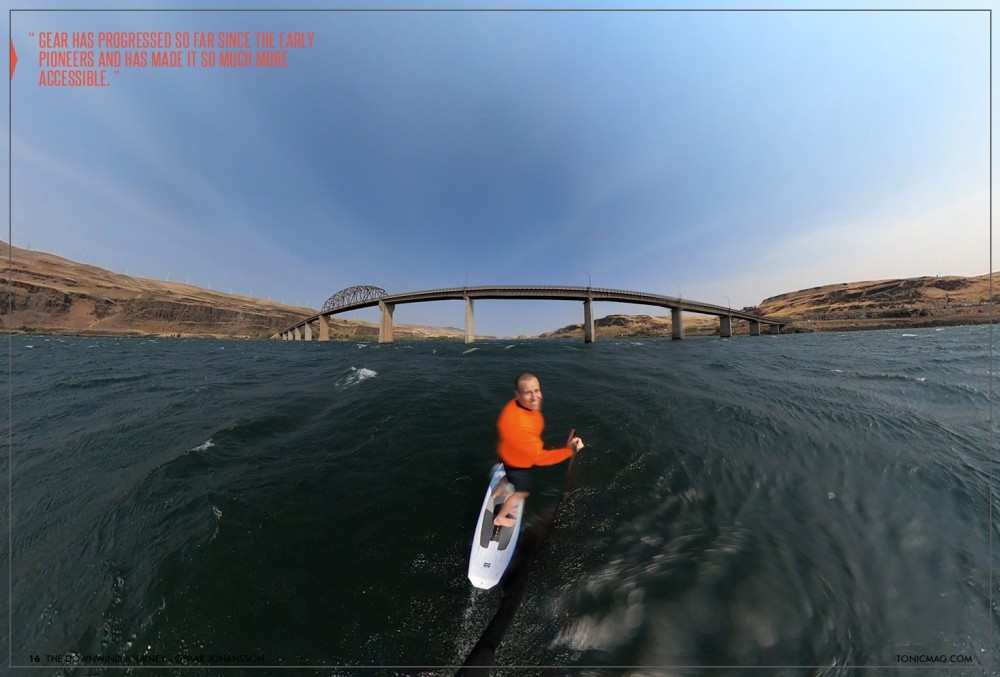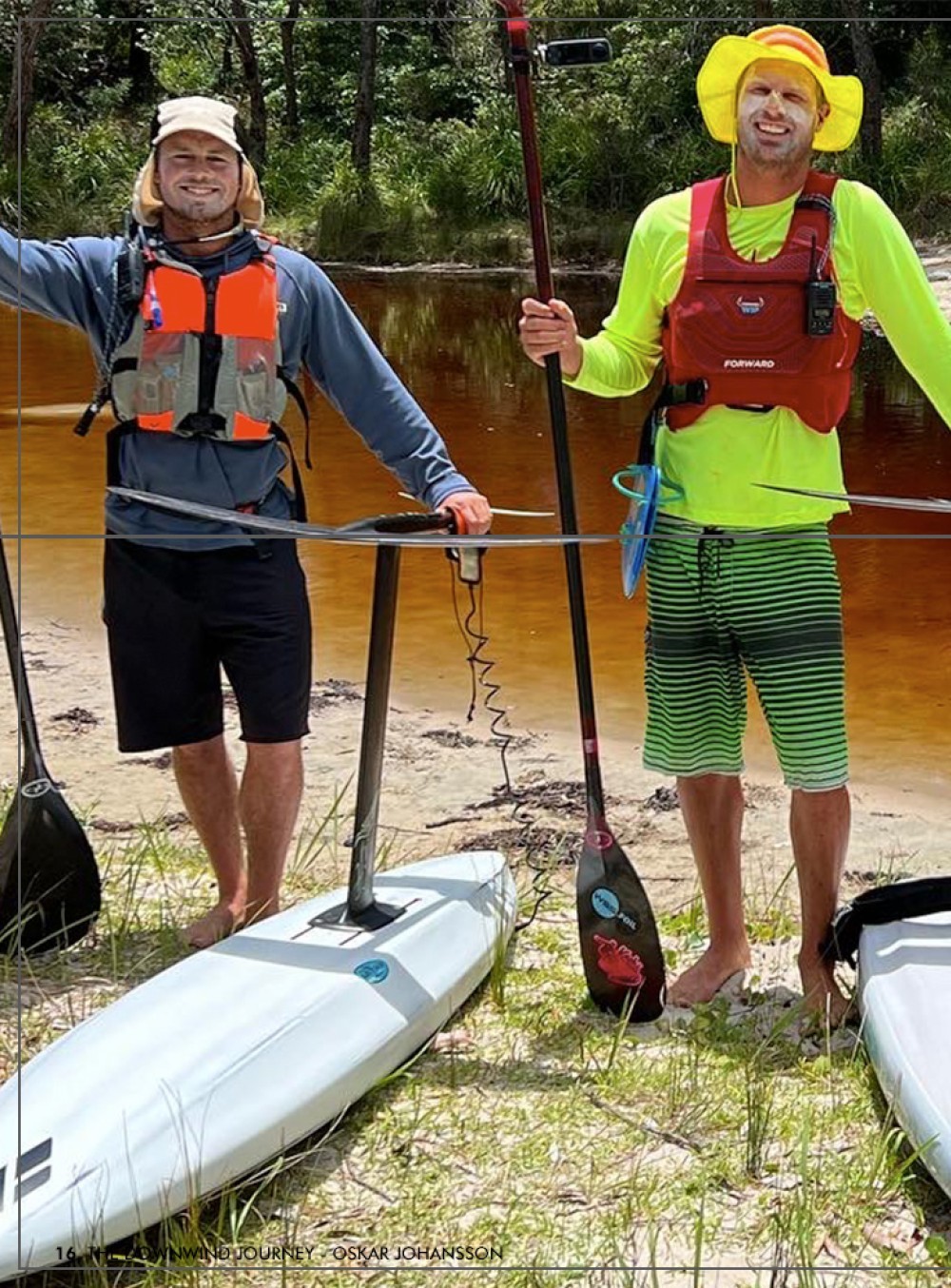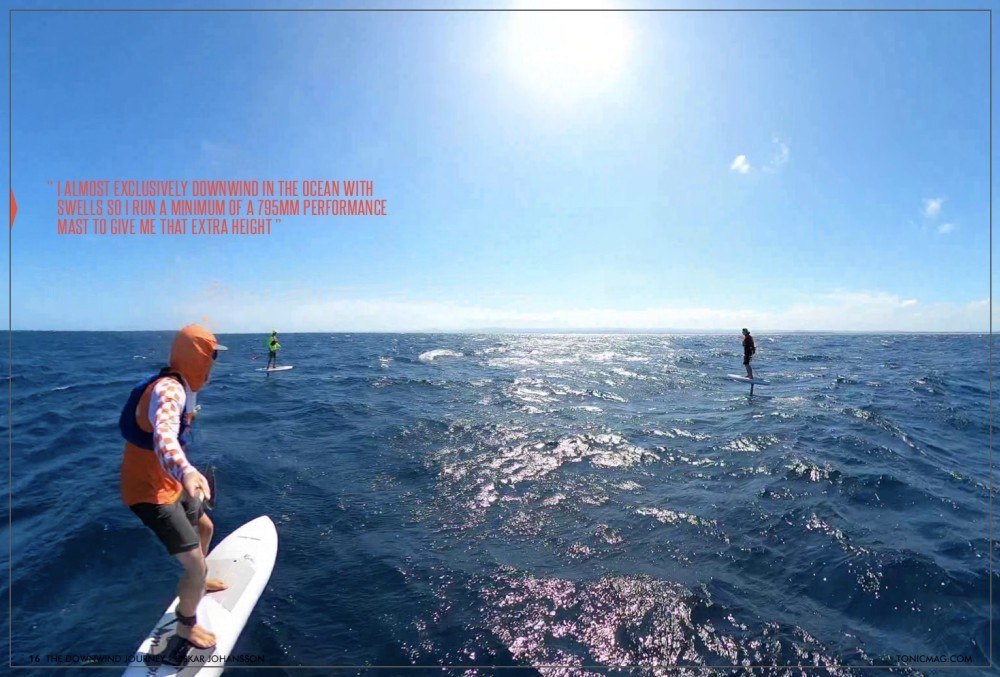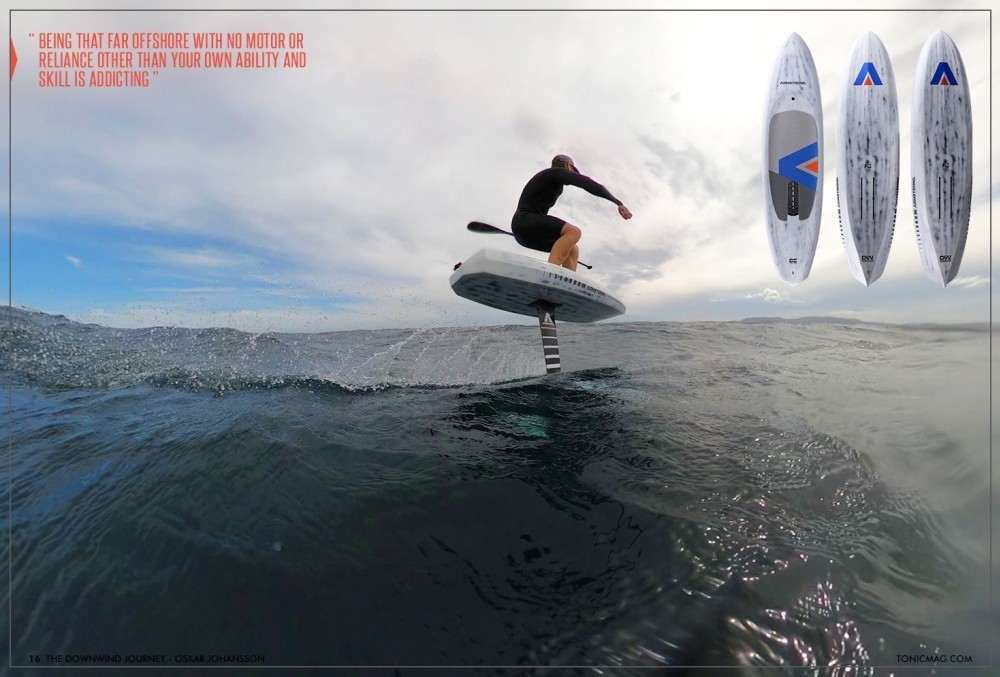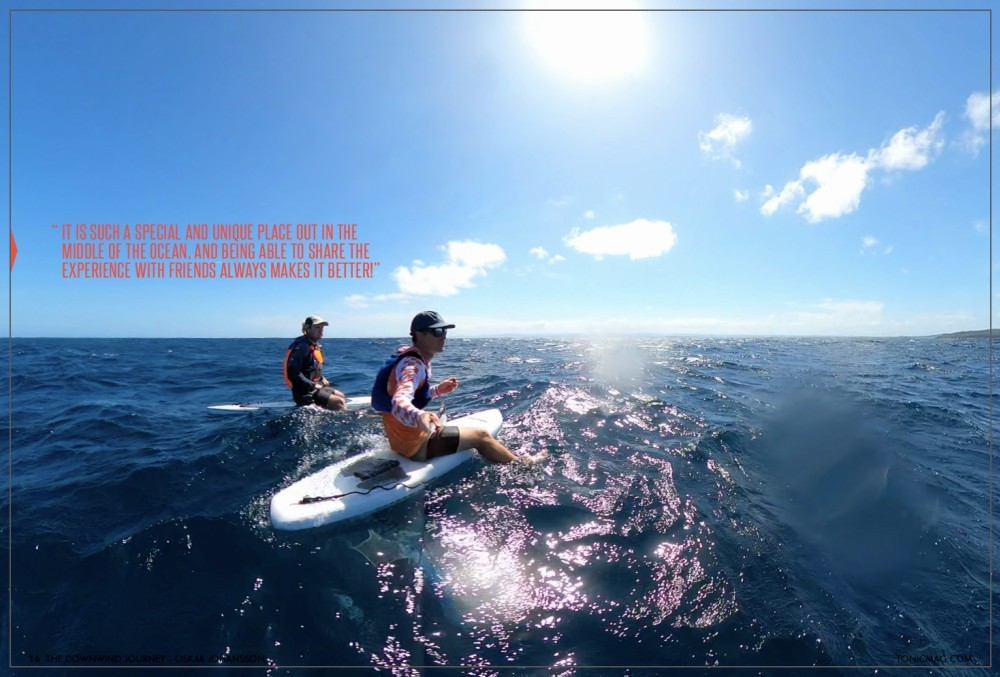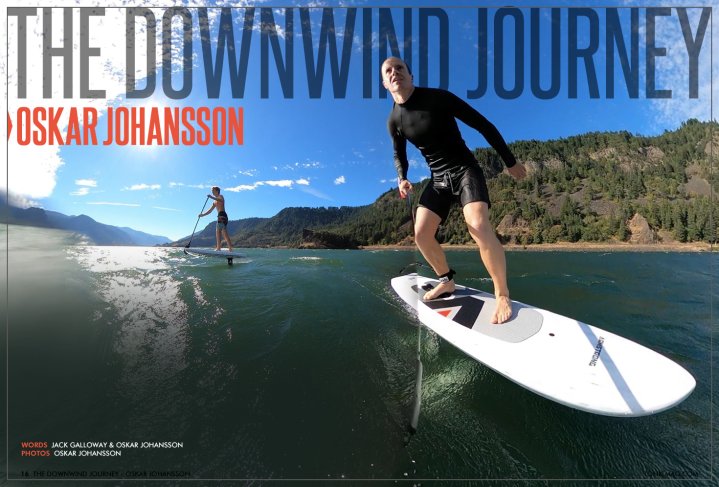
The Downwind Journey - Oskar Johansson
Issue 16 / Mon 29th May, 2023
Oskar played an integral part in the creation of the Armstrong Downwind SUP. We caught up with him to find out all about the process and how his foil obsession progressed to a downwind obsession.
Hey Oskar, great to have you join us again. Firstly, when did you first realise that downwind SUP foiling was something you wanted to do?
To be honest it really didn’t appeal to me for quite a while. I never SUP’ed and coming from a prone surf background the idea of riding such a big board just didn’t appeal to me. We did a few prone downwind runs with a jetski but the logistics of getting the trailer to the finish point just meant we didn’t do it often. Eventually, it was a friend, Zane Westwood, who talked me into it. But I still went into the process very hesitant.
Tell us about your downwind journey, what was the learning process like? What gear did you start on?
Looking back on my DW journey I was somewhat lucky that I waited as long as I did. Gear has progressed so far since the early pioneers and has made it so much more accessible. I started on a friend's Sunova Aviator 6’4” with the Armstrong HA1325. I had the idea of just going straight out for my first downwind run and tried to paddle out from a local boat ramp and quickly realised I couldn’t even paddle the board in a straight line. In the end, the whole journey from learning to paddle to DW’ing was about 3 weeks. I spent a session in the lake learning the “j” stroke and how to paddle straight, then progressed into the surf to learn the transition from paddling to then being on foil. I just progressively worked on paddling up on smaller and smaller bumps and trying to get the paddle pump technique to assist with releasing the board from the surface. I then had a session paddling about 1-2km out in onshore winds and practicing paddling up on the way back. This really taught me to not try and paddle for the big swell bumps but for the steep little wind chops. My first real attempt was 3 weeks into the journey with Zane which was a 9km run across a bay which to my surprise was successful. Even after doing my first run, I knew I wanted a completely different board. At the time nothing was available so I decided to make my own. At the time boards were about 25-29” wide so I went 22.5” wide, and 5’10” long. Maybe it was a bit arrogant for my first board, James Casey and Zane gave me no confidence and said it was too extreme, but it ended up working great! The boxes were also way further forward which made it feel super nimble and responsive.
You’ve had a big input in the design of Armstrong’s Downwind SUP. Can you fill us in on the process of designing a board with Armstrong. What did you start with shape-wise? Who did you work with? How many prototype boards did you go through?
It was quite a natural evolution. Armstrong said that they could make me a custom DW SUP board and I immediately jumped on it. Having shaped surfboards since I was young and now having shaped my own SUP I already had so many ideas and features I wanted to put into the board. I was honestly nervous to let someone else design it, so I decided I would draw something up in CAD and send it to them. My drawings were rough at best though, and so many aspects of the board were terrible, but Armie worked his magic and brought the design into an actual board. There were so many aspects from the bevels in the rails, to rocker and volume distribution that he fine-tuned to make it into the first board. It started out at 79L, 5’11” x 18 ½” and Armie made four of them with different bevels and constructions to test at the AWSI event in Hood River. Instantly they were better than anything else I had ridden, but we still had a lot of ideas and changes. This took at least an additional 5-6 iterations on that one size until we arrived at the 85L board that is available today. The amount of boards then prototyped to make each of the additional sizes in the range would be a fairly sizeable number!
Shape-wise, they’re not as aggressive in terms of length & width as some brands are. Was that deliberate or something that naturally turned out to be the best performance?
There are a number of variables that control the limits in board dimensions. Of course longer and narrower are easier to paddle up, but eventually, you get to a point where you can paddle up far too small of a foil than you can actually downwind. At that point having such a long board is detrimental to the performance while downwinding. It becomes more difficult to handle in tighter bumps as it's susceptible to nose-diving, and the response of the board decreases as it gets longer through the increased swing weight. Width also has its limits in that you still need to cater for the rider's offset stance and foot size. For example, my limit with a US size 9 shoe and not much offset is 17”. You then have to factor in people with more offset stances and riding positions and that is where we landed at 18 ¾” for the 6’3” model that I ride. Ultimately where we ended up was a board that balances the dimensions so that it is accessible to intermediate foilers, but something you won't outgrow as you progress with your downwind journey. Interestingly on James Casey’s latest “Thursday Thoughts” he talks about this and the trend now going back to shorter boards but maintaining that narrow width… so hopefully we got that right haha.
You’ve been doing some huge ocean runs. 80km being the longest I believe? What’s your go-to setup at the moment?
Yeah, 83km is my longest so far, but I am already looking for way longer runs. I always ride the 6’3” x 18 ¾” at 85L Armstrong DW board and mast very far forward, 11 on the tracks. I almost exclusively downwind in the ocean with swells so I run a minimum of a 795mm performance mast to give me that extra height for dropping into the bigger swells with confidence to not breach. Fuse length I have been experimenting a lot with. There are a lot of pros/cons with different lengths, but ultimately as I have progressed onto smaller front wings where I like the additional stability and projection on the pump of the longer 70cm fuselage. In light wind conditions or during a bay/enclosed water run then I go for the 60cm fuse. And front wing I basically only ride the HA925 in everything. I can paddle up the HA725 fairly comfortably but it's too quick to cruise with the wind bumps which makes it a lot more work to DW.
What do you think about flat water paddle-ups as part of the progression? Is it worthwhile or should people go straight out to the bumps?
I never did flat water paddle-ups, but I wish I did. It really highlights all of your weaknesses. It is also one of the only ways to really work on the paddle pump technique while getting on foil. Paddling up in the surf you always “catch” the wave and don’t get many opportunities to really work the board up onto foil. In the flat water, there is nowhere to hide, and you have to get everything right to make it work. All of those skills translate to being out in the bumps and working the board up onto foil.
What is it about downwind foiling that appeals so much? How popular do you think it will become?
To me, it's the adventure, and to some extent the risk. Being that far offshore with no motor or reliance other than your own ability and skill is addicting, it's a complete flow state where you have to be present. Everything that you’ve learned in foiling is used while downwinding and it takes all of your concentration and ability. Even when you think you’ve got it “mastered” you can progress to a smaller foil, faster average speeds, and longer distances. Eventually, you’ll find yourself checking every wind forecast model daily, scouring google maps for stretches of coastlines that would suit particular direction winds and then possible starting and exit points.
As for how popular will it get, I think it will continue to grow steadily. With gear becoming more accessible not just to downwinding but progression of foiling in general, more and more people will have the skills and ability to downwind. Aside from rider ability, the attraction of adventure is something I think a lot of people want to get involved with. It also gives you the opportunity to pioneer those adventures along your own stretch of coast.
What advice do you have for people that are new to the discipline?
As much as I hate to say it, buy the latest downwind gear. There has been so much progression in gear to make downwinding more accessible. Even looking back 6 months the boards coming out then are almost irrelevant now. We have landed on some good trends so think about your ability and experience, and choose a board accordingly with some room to grow into it. Secondly, ride a way bigger foil than you would ever dream of. There is nothing worse than not getting on foil, so make the learning process easier on yourself. And lastly, try and enjoy the suffering. There will be plenty of frustration and cursing, but try and enjoy the process. It makes the reward of downwinding so much more satisfying!
What safety equipment do you take with you when downwinding?
There are a few things I always take with me. Firstly a tool, in case I didn’t tighten something up or if you need to come in at a different point and disassemble your foil (touch wood I have never needed it yet). Secondly a phone. I use a Pelican waterproof floating case and never do a run without it. I always share my live locations with anyone I am doing the run with, or with family/friends that know I am out there. I do most of my runs alone so having people able to see my location is key. I also share my location with the local maritime through their app in case I need rescuing, but also if someone from the public calls worried about a person paddling way offshore then they can see if it was me they were talking about and can call before sending out a full search party. I also always wear high-vis shirts for visibility from land but also to keep an eye on each other during a run. We have also tried marine walkie-talkies but in the bumps they seem to have a fairly useless range and we have just had too many issues with them to prove reliable. Also if you don’t have good reception I would recommend an EPIRB or similar emergency device.
You’re well known for your record-breaking pump foiling. Do you have any specific goals within downwind foiling?
My biggest goal at the moment is the M2O race in July. It has always been a dream to ride in the Hawaiian conditions, but to do it between two of the islands in the middle of the ocean seems like such an amazing experience. After that, I just want to explore doing more adventurous downwind runs. Pushing how far we can go, but also doing it with a good group of friends. It is such a special and unique place out in the middle of the ocean, and being able to share the experience with friends always makes it better!
Best of luck in July! You’ll smash it I’m sure. Thanks for chatting Oskar.
Videos
By Tonic Mag


